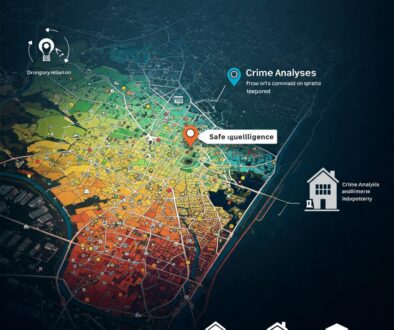Flood Risk and Property Investment: Using AI for Long-term Planning
Flood risk has traditionally been one of the most misunderstood and inadequately assessed factors in real estate investment. As climate change accelerates and extreme weather events become more frequent, the ability to accurately assess flood vulnerability is increasingly crucial for property investors seeking to protect their capital and ensure long-term returns.
Traditional flood risk assessment typically relies on FEMA flood maps that are often outdated, binary in their designations, and unable to account for changing climate conditions. This limited approach leaves investors vulnerable to significant unforeseen risks that can dramatically impact property performance and value.
In 2025, AI-powered geospatial intelligence platforms like Locas.dev are revolutionizing flood risk assessment, providing nuanced, forward-looking analysis that helps investors make more informed decisions about flood vulnerability and develop effective mitigation strategies.
The Evolution of Flood Risk Assessment in Real Estate
Traditional Approach
Conventional flood risk assessment in real estate typically involves:
- FEMA flood zone maps for basic in/out designations
- Historical flooding records where available
- Simple elevation checks during property inspections
- Standard insurance determinations based on flood zones
- Local anecdotal knowledge about past flooding events
This approach has critical limitations:
- Binary designations that miss nuanced risk variations
- Outdated information that doesn’t reflect current conditions
- Limited forward projection of changing flood patterns
- Minimal consideration of infrastructure vulnerability
- Inadequate assessment of different flood type risks
“Traditional flood maps essentially draw a line and say you’re either in a flood zone or you’re not,” explains Dr. Sarah Johnson, hydrologist. “In reality, flood risk exists on a spectrum with many properties outside official flood zones facing significant yet unrecognized vulnerability, while some properties within zones may have better-than-expected resilience due to specific characteristics.”
How AI Transforms Flood Risk Assessment
Modern geospatial intelligence platforms transform flood risk analysis through:
1. Multi-Factor Flood Vulnerability Modeling
Traditional Approach: Simple determination of whether a property falls within FEMA-designated flood zones, missing important nuances in actual vulnerability.
AI-Enhanced Approach: Sophisticated flood intelligence includes:
- Micro-topographical analysis at sub-meter resolution
- Local drainage pattern modeling specific to the property
- Surface permeability assessment affecting water absorption
- Infrastructure vulnerability evaluation for flood control systems
- Multiple flood type risk assessment (riverine, coastal, pluvial, groundwater)
Real-World Impact: “We were evaluating a property that fell just outside a FEMA flood zone, suggesting minimal flood risk under traditional assessment,” notes Michael Chen of Meridian Investments. “However, AI-powered analysis revealed the property sat in a subtle depression with limited drainage options, creating significant pluvial flood vulnerability during intense rainfall events—a risk completely missed by conventional flood maps. This intelligence allowed us to either negotiate appropriate pricing or avoid a potentially costly investment mistake.”
2. Climate Change-Adjusted Risk Projection
Traditional Approach: Reliance on historical flood patterns with little consideration of how climate change might alter future flooding probability and intensity.
AI-Enhanced Approach: Forward-looking flood risk intelligence includes:
- Climate model integration for precipitation pattern changes
- Sea level rise projection effects on coastal and tidal properties
- Storm intensity evolution modeling for extreme event impacts
- Snowmelt pattern changes affecting seasonal flood risk
- Multiple timeframe analysis across 10, 30, and 50-year horizons
Real-World Impact: A long-term investor was considering a coastal development that showed minimal historical flooding and fell outside current flood zones. AI-powered climate projection analysis revealed the property had a 68% probability of regular tidal flooding within 25 years due to projected sea level rise—well within the expected hold period for the investment. This intelligence led to a fundamental reconsideration of the development approach, incorporating elevated construction and natural buffer zones that would maintain viability despite changing conditions.
3. Infrastructure Dependency Assessment
Traditional Approach: Limited evaluation of flood control infrastructure, typically assuming current systems will maintain effectiveness indefinitely.
AI-Enhanced Approach: Comprehensive infrastructure intelligence includes:
- Flood control system condition evaluation
- Infrastructure capacity modeling under changing conditions
- System failure probability assessment
- Maintenance and upgrade trajectory analysis
- Multiple infrastructure dependency identification
Real-World Impact: “The AI analysis identified critical vulnerabilities in the levee system protecting an investment property,” explains Jennifer Wu of Capital Partners. “While the system appeared adequate in standard evaluations, the platform detected maintenance deficiencies and design limitations that created a 37% probability of failure during severe but plausible storm events. This intelligence informed our decision to implement property-specific flood mitigation measures rather than relying solely on the public infrastructure.”
4. Financial Impact Quantification
Traditional Approach: Basic understanding that flood events cause damage, but limited ability to quantify specific financial implications across different scenarios.
AI-Enhanced Approach: Detailed financial risk intelligence includes:
- Damage cost modeling across multiple flood scenarios
- Insurance premium trajectory projection
- Business interruption loss estimation
- Property value impact analysis under changing risk profiles
- Mitigation investment ROI calculation
Real-World Impact: An investor used AI-powered financial impact analysis to evaluate two similar properties with different flood risk profiles. While the higher-risk property offered better initial returns, the comprehensive financial analysis revealed that increased insurance costs, potential damage expenses, and long-term value impact created a 22% disadvantage in risk-adjusted returns over a 10-year hold period. This quantitative assessment enabled a data-driven investment decision beyond simple flood zone designations.
5. Mitigation Opportunity Identification
Traditional Approach: Generic flood mitigation approaches with limited property-specific optimization or cost-benefit analysis.
AI-Enhanced Approach: Sophisticated mitigation intelligence includes:
- Property-specific vulnerability analysis identifying key risk points
- Custom mitigation strategy recommendation
- Cost-effectiveness ranking of different approaches
- Implementation phasing optimization
- Residual risk assessment after mitigation
Real-World Impact: “Rather than implementing a standard flood mitigation approach, we used AI analysis to identify the specific water entry vulnerabilities unique to our property,” notes Robert Martinez of Urban Development. “This allowed us to implement targeted measures that reduced flood risk by 83% while spending 62% less than a comprehensive mitigation approach would have cost. The system essentially identified the critical 20% of potential measures that would address 80% of the actual risk.”
Case Study: The Riverside Development
When Horizon Development was evaluating a mixed-use development opportunity along an urban riverfront, they employed both traditional flood risk assessment and AI-powered hydrological analysis:
Traditional Assessment:
- Property was outside the 100-year FEMA flood zone
- No record of significant flooding in recent decades
- Site elevation appeared adequate in general survey
- Standard flood insurance was readily available
- City had recently upgraded some flood control infrastructure
AI-Enhanced Intelligence:
- Climate models showed 48% increased probability of extreme precipitation events by 2045
- Micro-topographical analysis identified potential water accumulation zones on the property
- Infrastructure assessment revealed stormwater system inadequacy during intense rainfall
- Projected flood levels under extreme events would impact ground floor uses
- Multiple viable mitigation opportunities identified with cost-benefit analysis
Based on this comprehensive intelligence, Horizon:
- Redesigned their ground floor with floodable uses and water-resistant materials
- Incorporated site-specific water management systems addressing identified vulnerabilities
- Implemented strategic landscape features to direct water flow away from critical areas
- Phased their development to prioritize elements with lower flood vulnerability
- Created flexible spaces that could adapt to changing environmental conditions
The result was a development that maintained viability and value even as nearby properties experienced significant flood impacts during subsequent extreme weather events, demonstrating the strategic advantage of forward-looking flood intelligence.
Key Flood Risk Factors for Comprehensive Assessment
Modern geospatial intelligence platforms analyze several critical dimensions to create complete flood risk profiles:
1. Property-Specific Characteristics
- Elevation and topography relative to water sources
- Drainage characteristics and water pathways
- Ground permeability affecting water absorption
- Building foundation type and vulnerability
- Critical system placement (electrical, mechanical, etc.)
2. Environmental and Climate Factors
- Precipitation pattern projections under climate change
- Sea level rise trajectories for coastal properties
- Watershed condition assessment affecting water flow
- Groundwater level trends impacting subsurface flooding
- Snowmelt pattern evolution in applicable regions
3. Infrastructure Considerations
- Flood control system adequacy and condition
- Stormwater management capacity under various scenarios
- Drainage infrastructure assessment for the specific area
- Maintenance patterns for relevant systems
- Planned improvement trajectory for flood infrastructure
4. Historical and Projected Patterns
- Historical flood events beyond official records
- Past near-miss situations indicating vulnerability
- Evolving development patterns affecting water flow
- Land use changes impacting flood dynamics
- Historical infrastructure performance during extreme events
5. Insurance and Regulatory Factors
- Flood insurance availability and cost projections
- Regulatory evolution patterns for flood-prone areas
- Disclosure requirement changes affecting marketability
- Building code trajectory for flood-related standards
- Federal program changes impacting flood-prone properties
Implementing AI-Powered Flood Intelligence in Your Investment Strategy
To leverage these advanced capabilities in your real estate investment approach:
1. Move Beyond Binary Flood Zone Designations
Adopt a more nuanced understanding of flood risk:
- Recognize the spectrum of vulnerability across all properties
- Assess multiple flood types beyond simple riverine flooding
- Consider climate change impacts on future flood probability
- Evaluate specific property characteristics affecting vulnerability
- Assess infrastructure dependencies and vulnerabilities
2. Incorporate Flood Risk in Financial Analysis
Quantify flood risk impacts across your investment model:
- Project insurance cost trajectories based on changing risk profiles
- Model potential damage costs across different flood scenarios
- Assess potential business interruption or vacancy impacts
- Consider resale implications of evolving flood risk perceptions
- Calculate mitigation investment returns relative to risk reduction
3. Develop Strategic Mitigation Approaches
Create property-specific flood resilience strategies:
- Implement targeted mitigation addressing identified vulnerabilities
- Phase investments based on risk magnitude and probability timing
- Design adaptable spaces that can evolve with changing conditions
- Incorporate natural risk reduction approaches where appropriate
- Create operational protocols for managing flood events
4. Optimize Portfolio-Level Flood Risk
Manage flood exposure across your investment portfolio:
- Balance properties with different flood risk profiles
- Diversify across regions with varying climate change trajectories
- Match flood risk exposure to investment time horizons
- Develop specialized expertise in high-opportunity flood-resilient investments
- Create portfolio-wide insurance and risk transfer strategies
5. Monitor Evolving Flood Landscapes
Recognize that flood risk is dynamic rather than static:
- Track climate indicators affecting future flood patterns
- Monitor infrastructure maintenance and improvement activities
- Stay informed about changing flood insurance programs
- Observe regulatory evolution affecting flood-prone properties
- Update mitigation strategies as flood understanding evolves
The Future of Flood Risk Intelligence
As AI and geospatial intelligence continue to evolve, several emerging capabilities promise even more sophisticated flood risk assessment:
Real-Time Flood Monitoring and Alert Systems
Future platforms will integrate with sensor networks and weather systems to provide real-time flood risk alerts and monitoring for specific properties.
Dynamic Flood Simulation Visualization
Advanced systems will create immersive visualizations of property-specific flood impacts under various scenarios, enabling more intuitive understanding of risks and mitigation options.
Automated Mitigation Design Optimization
AI will increasingly generate property-specific flood mitigation designs optimized for cost-effectiveness, automatically balancing protection levels against implementation costs.
Predictive Insurance Market Modeling
Future intelligence will forecast changes in flood insurance availability, requirements, and pricing based on evolving risk patterns and regulatory trends.
Integrated Climate-Flood-Value Projection
Platforms will provide comprehensive projections linking climate changes to flood risk to property value impacts, enabling truly long-term investment planning.
Conclusion: From Flood Vulnerability to Resilience Advantage
Flood risk represents both a significant threat and a strategic opportunity for informed real estate investors. The evolution from simplistic flood zone designations to sophisticated AI-powered flood intelligence allows investors to:
- Identify hidden vulnerability missed by traditional assessment
- Quantify financial implications of changing flood patterns
- Implement targeted mitigation strategies for optimal protection
- Discover undervalued opportunities in misunderstood locations
- Future-proof investments against changing climate conditions
In an environment of increasing climate uncertainty, the competitive advantage increasingly belongs to investors who can accurately assess and strategically manage flood risk across their real estate portfolios.
Ready to transform flood risk from an uncertain threat to a managed factor in your investment strategy? Try Locas.dev today and experience the power of AI-driven flood intelligence for your real estate investments.
This article reflects the current state of AI technology in flood risk assessment for real estate. For the latest updates and features, visit Locas.dev.
Keywords: flood risk real estate, property flood analysis, climate change flood impact, AI flood assessment, property flood vulnerability, real estate flood mapping, flood mitigation ROI



